117 What Happens When Dogs Eat Raw Meat? Exploring GI Physiology and Raw Meat Consumption in Dogs
beson026; helke010; and quast147
Lesson Objectives
- Understand the basic principles of gastrointestinal physiology in humans.
- Explore the digestive system of dogs and its adaptations.
- Examine the potential risks and benefits of feeding raw meat to dogs.
Introduction
- What happens to food after we eat it? Why is digestion important?
The food we consume goes through the digestive system, which is broken down into its simplest forms to allow for proper absorption and distribution throughout the body.
Proteins → amino acids
Carbohydrates → glucose
Fats → fatty acids
The nutrients from the food that has been broken down are absorbed into the bloodstream and then transported throughout the body.
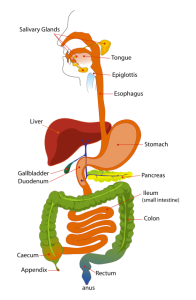
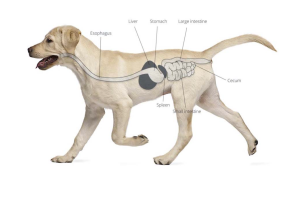
Mouth
The mouth is a complex structure that acts as the primary entry point to the digestive system. The teeth, aided by the tongue, play a crucial role in the mechanical breakdown of food into smaller, more manageable pieces. The digestive process starts in the mouth for some species, and for humans, this is due to the presence of salivary amylase, an enzyme that helps break down carbohydrates. This enzyme begins the process of chemical digestion by breaking down complex carbohydrates into simpler sugars that are more easily absorbed by the body. This initial digestion process in the mouth sets the stage for the rest of the digestive process to occur smoothly and efficiently.
Esophagus
The esophagus connects the pharynx to the stomach and transports food and liquids. Swallowing involves complex mechanisms that push food down the esophagus while preventing it from entering the airway. The muscles in the pharynx and tongue work together, while the soft palate and epiglottis close off the nasal and oral cavities and the larynx.
Food is propelled down the esophagus by a series of coordinated contractions of the muscles in the esophageal wall. This process, called peristalsis, is controlled by the enteric nervous system. As the food approaches the stomach, the lower esophageal sphincter (LES) relaxes to allow the food to pass through into the stomach, preventing the stomach’s acidic contents from flowing back up into the esophagus.
Stomach
The stomach is a vital digestive system component that performs several essential functions. Firstly, it stores the food we eat and releases it slowly into the small intestine for further digestion. Secondly, it secretes hydrochloric acid (HCl), which plays a crucial role in breaking down food particles. However, HCl is also a highly corrosive compound that can damage the stomach lining. To protect itself from the harmful effects of HCl, the stomach has specialized cells that produce mucus. This mucus forms a protective layer over the stomach lining, preventing the acid from causing any damage.
As part of the digestive process, the stomach employs mechanical movement to break down the food that has been swallowed into smaller pieces. This process results in what is known as “chyme”. Once the food has been fully processed in the stomach, its contents are then released into the small intestine.
Small Intestine
The small intestine is a vital component of the digestive system, responsible for the majority of nutrient absorption and digestion. It is a long, narrow tube that connects the stomach to the large intestine and is divided into three sections: the duodenum, jejunum, and ileum.
The duodenum is the first section of the small intestine and is responsible for receiving partially digested food from the stomach. The jejunum is the middle section of the small intestine and is where most of the nutrient absorption takes place. The ileum is the final section of the small intestine and is responsible for absorbing any remaining nutrients and water.
The size and actions of the small intestine can vary greatly depending on the species. For example, in herbivores, the small intestine is much longer and more complex than in carnivores, as it needs to extract as many nutrients as possible from plant matter.
Large Intestine
The large intestine is also known as the colon. Once the food has been fully processed in the small intestine, the remaining food matter that has not been digested enters the large intestine. The primary function of the large intestine is to absorb water and electrolytes from this remaining food matter, which helps to maintain the body’s fluid balance. The large intestine also plays a crucial role in the elimination of waste products from the body.
Figure: breakdown of the enzymes utilized during each stage of digestion.
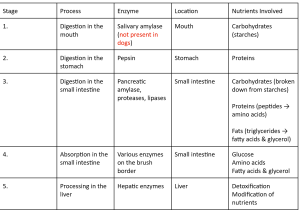
To test out what you have learned, label the spots on a dog GI system before. You’ve got this!
Canine Digestive System Exploration- Anatomy
The digestive system in dogs is split into multiple stages:
- Ingesting the food
- Chewing and swallowing using the tongue and teeth
- Digesting in the stomach
- Absorbing the nutrients in the small intestine
- Converting food to energy throughout the body- using metabolism
- Excreting wastes through the rectum
Depending on what diet an animal consumes, their digestive system reflects this. Dogs are considered omnivores- meaning they can consume a diet of both meat and plants. Although they are omnivorous, they have teeth adapted to a carnivorous diet, a diet consisting of only meat, that can be used to cut and tear flesh apart. The teeth in the dog include the incisors, canines, premolars, molars, and carnassial.
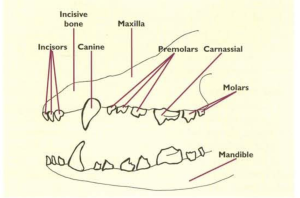
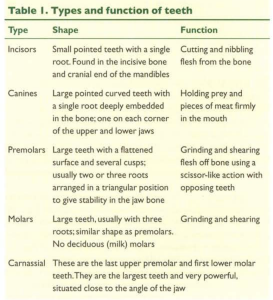
The oral cavity is made of the cheeks, tongue, lips, and salivary glands. All which play an important role in grinding and chewing food. The cheeks connect the sides of the jaw and have an inner mucous layer. The lips have upper and lower portions, they help to grab food and bring this into the oral cavity. The tongue lies on the floor of the mouth and is a skeletal muscle that moves chewed food to the back of the mouth for digestion. Paired salivary glands secrete saliva, which is composed of water, mucus, and electrolytes.
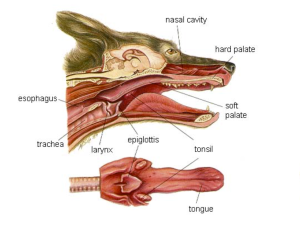 After leaving the oral cavity the food travels to the esophagus, which is a simple muscular tube in the dog that has coordinated muscular movements called peristalsis. Peristalsis is essential for movement of the food down the esophagus and is coordinated with brain activity.
After leaving the oral cavity the food travels to the esophagus, which is a simple muscular tube in the dog that has coordinated muscular movements called peristalsis. Peristalsis is essential for movement of the food down the esophagus and is coordinated with brain activity.
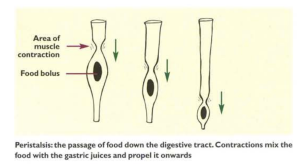
The esophagus reaches the stomach, which is a C-shaped organ that lies on the left side in the upper abdominal cavity. The stomach has two sphincters, which allow the movement of food into and out of it. The sphincter that allows the movement of food into the stomach is called the cardiac sphincter. The sphincter that allows the movement of food out of the stomach is called the pyloric sphincter. The stomach itself is divided into four sections. These consist of the cardiac, fundus, body, and pyloric regions. The stomach is lined with a mucus-like layer that protects it from irritation by the stomach acid.
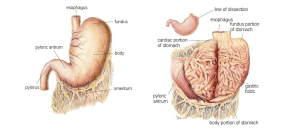
Since the GI tract of dogs is adapted to a carnivorous diet, their stomach acid has a much lower pH. To put this into perspective, the pH in a human stomach is between 1.5 and 3.5. The pH in the stomach of a carnivore is around 1.0. This means the stomach acid is much more acidic in dogs than humans. The reason dogs have this is because carnivores are constantly eating rotting flesh and tissue that is loaded with bacteria. The high acidity of the stomach acid works by killing this bacteria in the stomach, dissolving bones, and tough connecting tissues. This is similar to how a raw diet is digested by household pets.
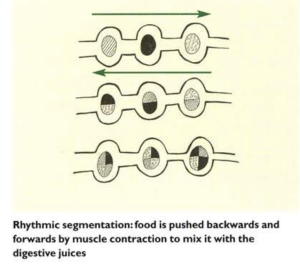
Flesh and meat are relatively digestible, meaning the intestine in the dog is short and takes place in one simple stomach. This directly contrasts with ruminants (cows and sheep), which have a segmented stomach. The small intestine follows the stomach.
As previously mentioned in introductory sections, the small intestine is where the majority of enzymatic digestion and absorption takes place. This is the longest portion of the gastrointestinal tract. The small intestine is divided into three sections: the duodenum, jejunum, and ileum. It should also be noted that the small intestine in the dog has villi, which is small, fingerlike projections that line the small intestine and increase its absorption abilities.
After the small intestine the food moves to the large intestine, which is similar to the small intestine, but it has a larger diameter, more mucous secreting cells, and no villi. In the dog and cat, the main function of the small intestine is to absorb water and electrolytes. The large intestine consists of three parts: the cecum, colon, and rectum. The cecum is a sac that sits just beyond the ileum (the last part of the large intestine). It has little function in carnivores. The colon is divided into ascending, transverse, and descending. Additionally, the rectum is close to the root of the tail and is where feces is excreted out the anus.
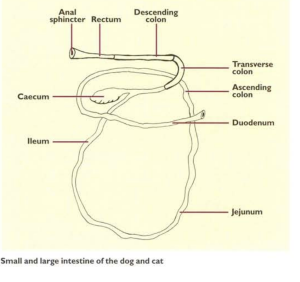
Specific GI Physiology for Raw Meat Digestion- A comparison between humans and dogs
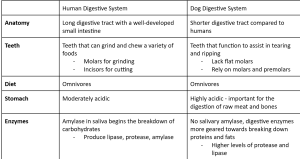

Raw Meat Diet Debate
A raw meat diet has grown in popularity over the last few years among dog owners. There are both risks and benefits associated with this type of diet. It is often believed that a raw meat diet gives dogs access to a more “natural” diet, strengthens their teeth, and is easier to digest. These claims are not based on scientific evidence and are instead driven by the owner’s desire to strengthen their bond with their dog and provide them with a great quality of life. However, there are several options available for owners to do these same things, but without the introduction of a raw meat diet that can pose a serious health risk.
Risk: Pathogen-Contaminated Raw Meat
Some risks of utilizing a raw meat diet are the possibility of ingesting pathogens. Pathogens that can contaminate meat include bacteria, viruses, and parasites. There is a risk in feeding raw meat to dogs because it is near impossible to know if the meat has been contaminated. A majority of the time, these pathogens are destroyed after they are fully cooked through. For example, this is why it is important for people to cook their meat before eating it. If a dog were to eat contaminated raw meat, not only is their own health affected, but this presents a risk to others as well.
Risk: Health of People
As mentioned previously, if a dog were to eat raw meat, they are at risk of ingesting a pathogen. In turn, this pathogen can also spread from the dog to people. Some individuals are at a higher risk of contracting the pathogen, such as immunocompromised people, pregnant women, and developing fetuses. Pathogens can be spread to people in a variety of ways, whether it is through the feces, saliva, or other objects that have been contaminated in their environment. People who are more at risk of contracting the pathogen from the affected dog can grow very ill or in extreme cases, the situation can become fatal.
Risk: Nutritional Value
Raw meat diets are not always nutritionally balanced. This means that the dog is not receiving all of the nutrients they need to function properly. Reputable dog food companies will provide a well-balanced diet to be sold to dog owners. Many dog food companies have veterinarians oversee the nutritional content of their food products to ensure that the dogs who will be eating the diet have all of their nutritional needs met. However, in the case of a raw meat diet, those components of a nutritionally balanced diet are not always present. Many times, there are products within the raw meat diet that are too small of value or too large of value and can cause health issues for the dog.
Benefit: Under Investigation
Many owners claim that a raw meat diet has a variety of benefits that are not found in a commercial dog food diet. However, many of these claims are from low quality studies that are not backed by scientific evidence. There is yet to be more scientifically sound evidence from high quality studies. Therefore, any true benefits of a raw meat diet are yet to be brought forth.
Clarification Points
Even though the idea of feeding a raw meat diet can be appealing in many ways, it does not mean that it will impact the human-animal bond any more or less. There are many ways to build the relationship between the owner and the dog, that does not include feeding the dog raw meat. Owners can rest assured that they are feeding their dog a nutritionally balanced diet by buying from reputable dog food companies that are backed by science. This is one of many ways they can feel good about providing a healthy life for their dog, all the while keeping those around them more protected.
Conclusion
Now that you know what happens when we feed dogs raw meat, let’s see how far you have come and what you learned today. You learned the basic principles of the gastrointestinal system that turns the food we eat into energy the body can use for a variety of functions. The body breaks down the food we eat into smaller pieces, absorbs what it needs, and gets rid of any waste products it does not need. You learned which key organs are important for digestion, such as the mouth, esophagus, stomach, small intestine, and large intestine. You also learned which key enzymes are associated with each location. Next, you learned the digestive system of dogs and its adaptations as compared to the human digestive system. For example, the dog stomach is highly acidic which is important for the digestion of raw meat and bones. The digestive system of dogs is similar, but also has its differences as compared to humans. Lastly, you learned about the potential risks and benefits of feeding raw meat to dogs. Many of the claimed benefits of utilizing a raw meat diet is not backed by scientific evidence, as of today. However, there are many risks of feeding a raw meat diet that have been backed by science. Some of these risks include pathogen contaminated raw meat, negative effects on human health, and nutritional imbalance. Now that you learned quite a bit of information today, let’s put it to work!
Assessment
Works Cited:
Ahmed F, Cappai MG, Morrone S, Cavallo L, Berlinguer F, Dessì G, Tamponi C, Scala A, Varcasia A. Raw meat based diet (RMBD) for household pets as potential door opener to parasitic load of domestic and urban environment. Revival of understated zoonotic hazards? A review. One Health. 2021 Sep 16;13:100327. doi: 10.1016/j.onehlt.2021.100327.
Aspinall, V. 2004. Anatomy and Physiology of the Dog
and Cat 8. The Digestive System, Veterinary Nursing Journal, 19:3, 94-99, DOI:
10.1080/17415349.2004.11013260
Butowski CF, Moon CD, Thomas DG, Young W, Bermingham EN. The effects of raw-meat diets on the gastrointestinal microbiota of the cat and dog: a review. N Z Vet J. 2022 Jan;70(1):1-9. doi: 10.1080/00480169.2021.1975586. Epub 2021 Sep 19. PMID: 34463606.
Dressman JB. Comparison of canine and human gastrointestinal physiology. Pharm Res. 1986 Jun;3(3):123-31. doi: 10.1023/A:1016353705970. PMID: 24271517.
Freeman LM, Chandler ML, Hamper BA, Weeth LP. Current knowledge about the risks and benefits of raw meat-based diets for dogs and cats. J Am Vet Med Assoc. 2013 Dec 1;243(11):1549-58. doi: 10.2460/javma.243.11.1549.
Malone, E. 2023. Vet Med: Applied GI Physiology – Supplemental Notes. https://open.lib.umn.edu/vetphysioapplied/

